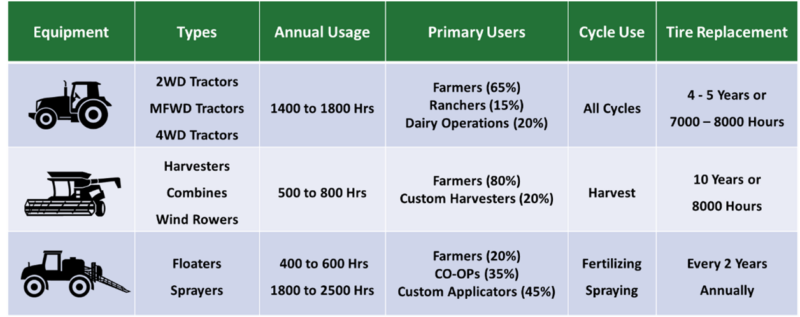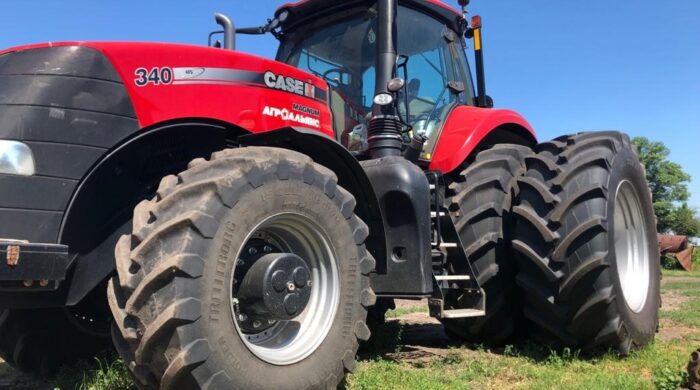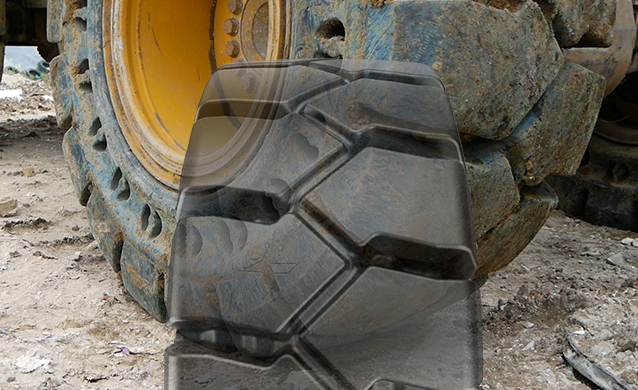In the agricultural industry, it is how the equipment is utilized or the inherent operational requirements that will affect tire life. As agricultural tires are considered “off-road” and not US Department of Transportation (DOT) regulated, there are no firm rules to determine when an ag tire needs to be replaced. However, how the tires are utilized will determine the usable service life of a tire. In all instances, the type of machinery, soil conditions, application (intensity of use), and air pressure maintenance will have a direct impact on its ability to deliver an improved service life. Listed in the below table are some general performance rules of the Ag industry, detailing expected tire life span or replacement cycles by platform or machine category:

General Performance Rules in the Ag Market for Large Ag Drive Tire Replacement:
- MFWD & 4WD Tractors (+100 HP) are 65% of the Market – What sells today as a new OE fitments replaces @ 5 years.
- Combine / Harvesters are 10% of the Market – What sells today as a new OE fitments replaces @ 10 years.
- Application Equipment is 15% of the Market – Tires are replaced every 1-2 years depending on the amount of roading.
All the above service life expectations are predicated on how the tires are mounted, used, and maintained. Listed below are some general reasons for tire removal or replacement in all cases, MAXAM recommends utilizing ag tires for the longest possible time regardless of the type of tire so long as the tire can be safely employed to meet operational requirements and deliver the value of the tires:
General Tire Replacement Guidelines for Farmers & Growers:
| Tire Impact | Tire Replacement Reason | Recommended Action |
| Increased Tire Slip | Adjusted tire inflation not working or tire tread depth (increased wear) reducing operational traction, great fuel consumption, or increased machine slip. | Tires may be too worn for the soil conditions or crop conditions of the operations. If tires are exceeding a 15% slip rate; MAXAM suggests replacing the tires. |
| Constant Air Leakage / Air Loss | Loss of traction due to poor air valve maintenance or tire cuts resulting in constant air loss. | Tire damages from operational use that result in tire leakage or loss of air required, either repair your tire or MAXAM suggests replacing the tires. |
| Cuts or Damages (stubble) in the Tread or Sidewall | Tire cuts, exposed casing cables, large damage, or deformities on the tread/sidewall are indicative of either external or internal damages impacting safe usage. | Evaluate the tires for damages that could impair operations or result in equipment damage while in operation = imminent failure or loss of tire integrity; MAXAM suggests replacing the tires. |
| Uneven Tire Wear | Tires are exhibiting uneven tire wear or more than 10% difference in tread depth on the same axle can result in a loss of traction, increased slip, increased fuel consumption, or can impact gear ratios. | Tires have uneven wear that can precipitate a loss of traction or increased fuel consumption and /or can also impact the gear ratio of a front wheel assist tractor; MAXAM suggests replacing the tires. |
| Side by Side Diameter Differences | Tires that have more than 5% difference in overall diameter mounted side by side or on the same axle can lead to a loss of traction, increases slip, can generate gear ratio issues, or increase soil compaction due to load shift. | Tire diameters need to be as closely matched as possible to prevent excessive slip / limit any gear ratio mechanical issues. Overall diameter differences can shift the axle load to the larger tire, increasing soil compaction; MAXAM suggests replacing tires. |
| Ozone Deformities or “Dry Rot” | Tires stored or equipment parked in the open can achieve excess sunlight or UV rays that can lead to ozone cracking that will degrade tire life or tread integrity. | Inspect tires in open storage or parked equipment for ozone cracks that expose internal materials such as working belts or casing materials; MAXAM suggests replacing the tires. |
The leading cause of tire replacement is severe tire wear or tire wear-out, resulting in a loss of traction noted by increased machinery slip rates. How a tire “wears” is directly linked to the actual weight being carried by each axle as dictated by the working speed of the machinery in service. If the tire’s cold inflation pressure is set to the right air pressure based on the axle load for a given work speed, all radial Ag tires (standard, IF or VF) are designed to deflect or bulge on the sidewall transmitting the optimal tire tread footprint to achieve a reasonable service life. In all cases, tire manufacturers must abide by industry standards that reference or set the recommended air pressure based on speed and weight bearing capability. If a farmer or grower chooses to lower the tire air pressure to increase the size of the tire footprint with the goal to achieve lower soil compaction or to gain more traction, then the axle load being carried must be measured/weighed so that the correct air pressure is identified to ensure optimal tire wear. Another advancement in the Ag industry to enhance both tire wear and service life is the addition of steel belts under the tread, improving both the stability or traction of the tread face while increasing the resistance to damage caused by spin cuts, stubble damage, or rock impacts. The final consideration in getting improved performance or greater service life from your radial Ag tires is to employ R-1W (W for Wet traction) type tires that are manufactured with +20% deeper tread than standard R-1 tires providing both higher resistance to damage and longer lasting tread rubber.
The advent of IF or VF Technology in radial tires has allowed some of the above rules to be re-written as farmers or growers can either significantly lower air pressure without compromising the carrying capacity of the tire or increasing the weight carried with the same tire footprint (same gross flat plate). Both technologies allow farmers to achieve better yields or greater productivity in the field with heavier or faster machinery. Also, another tool that is very popular in the European market and growing in the North American market is the use of “On-Board” Tire Inflation or Central Inflation Systems that deliver the capability to inflate or deflate the tires as needed based on the required work speed or axle load. It works by receiving data from either an RFID or sensor tag, located by wheel position on the machinery, and allowing the operator to adjust the tire inflation pressure in real time without having to stop the machinery ensuring enhanced tire service life.
In all instances, whether working in the field at slow speeds or transporting the machinery (roading) from field to field at higher speeds, managing proper tire inflation pressures for every work application will ensure that the tires can deliver the optimal performance and long service life by:
- Reducing ground compaction as tire load is based on the actual load per axle or per tire as needed.
- Greater crop yields as the compaction impact on the soil is minimized by the improved tire footprint.
- Improved tire wear and reduced sidewall deflection giving the optimum tire gross flat plate or footprint.
- Improved fuel efficiency as the tire is optimized for each work application or towed implement.
- Greater productivity in the field as the tire’s footprint and traction provide increased efficiency.
MAXAM’s AGRIXTRA product range has been engineered based on a given load or speed to ensure the optimal contact patch without compromising the steering, flotation, traction, or torque transfer capability of the tire. MAXAM is constantly developing new VF tires sizes to not only complement our existing offer, but to also meet the evolving global demand for higher load, platform, or market technological changes. MAXAM also uses steel belts in specific products to deliver an improved radial tire designed to provide a long service life.



